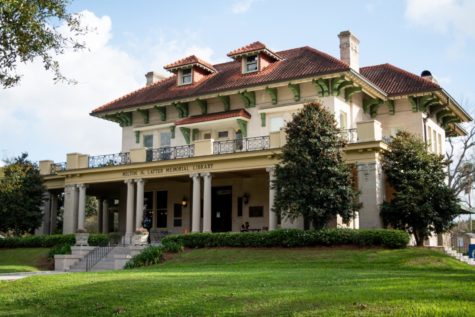Milton H. Latter Library’s storied past
March 1, 2023

Tucked beneath the live oaks of St. Charles Avenue lies a large, antiquated house in the neo-Romanesque style. Over a century old, the building, now known as the Milton H. Latter Memorial Library, serves as a branch of the New Orleans Public Library system. For New Orleans locals, the library is conveniently located next to the St. Charles at Dufossat streetcar stop. For Tulane students, it is simply a 20-minute walk from campus. Comfortably within walking distance, the Memorial Library is the perfect scene for those craving a spot to read, study or simply unwind.
I’m a great admirer of New Orleans architecture. I’ve walked past plenty of opulent houses in the city’s Uptown section alone and marveled at the structural beauty around me. I also have a profound love for libraries and the literature they possess. Naturally, I was delighted to find a site so close to me that married both concepts.
The Memorial Library has a long and colorful history, starting with its construction in 1907. The Isaacs family — successful merchants on Canal St. — commissioned the design for the mansion from the New Orleans-based Favrot & Livaudais architectural firm. The firm was responsible for many notable Louisiana landmarks, including the Oaks Hotel of Hammond and the Strand Theatre of Jennings. The mansion was subsequently erected by George Glover and decorated by various local artisans.
The patriarch of the Isaacs family passed in 1912, as did ownership of the house. The family sold the mansion to the Williams family, comprised of Frank B. Williams and his aircraft engineer son, Harry Williams. Harry married silent-film actress Marguerite Clark, and the two moved into the house.
After Harry’s tragic death in an aircraft accident in 1936, Marguerite abandoned the house, selling it to Robert S. Eddy in 1937. Eddy owned numerous horse tracks across the United States, and he used the income from his ventures to further furnish the already gorgeous mansion.
In 1947, the house changed ownership again. The local Latter family bought the mansion from the Eddy family after they moved to Florida. However, the Latters had no desire to live in the house. They had lost their son Milton in Okinawa during World War II and envisioned the building as a public library to commemorate their fallen boy. The family paid a grand total of $125,000 to buy and alter the mansion. After the building was donated to New Orleans, the city spent an additional $15,000 to transform the house into a proper library — it was open for public use by the end of 1948. The Memorial Library closed briefly in the 1980s for renovations, and a member of the Latter family generously provided part of the sum needed.
For years, the mansion has stood on St. Charles watching the streetcars roll by. Its tenants have changed in the century since its construction, yet the building’s elegance has largely remained the same. Upon entering the lobby, you’ll feel like you’ve entered not a public library, but an extravagant manor for aristocrats. Mahogany paneling surrounds and guides you to the first-floor reading rooms, each one converted from its original early 20th century purpose. Glittering chandeliers hang delicately above your head and, in the Pink Room, a mural covers the ceiling with cherubs in heavens. An aged wooden staircase winds into an upstairs children’s wing.
The Memorial Library has served me well throughout my first few months as a Tulane student. Whenever I need a change of scenery from Howard-Tilton Memorial Library’s sterile aesthetic, I stroll down to the mansion on St. Charles and immerse myself in its inviting atmosphere.
Regardless of whether I’m settling into a book for pleasure — the branch has almost 50,000 reading materials in-house — or tackling my homework for the day, I feel at peace in the old library. I encourage my fellow students to patronize this local institution and take advantage of its historical and comforting riches.






















Leave a Comment